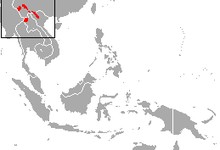Western black crested gibbon
| Western black crested gibbon | ||||||||||||
|---|---|---|---|---|---|---|---|---|---|---|---|---|
| Systematics | ||||||||||||
|
||||||||||||
| Scientific name | ||||||||||||
| Nomascus concolor | ||||||||||||
| ( Harlan , 1826) |
The Western Black Crested Gibbon ( Nomascus concolor ) is a primate of the family of gibbons (Hylobatidae).
features
The western black crested gibbon reaches a head body length of 43 to 54 cm and a weight of 6 to 10 kg. Just like all other species of the genus Nomascus , this species also has a pronounced sexual dimorphism . Males are completely black with a noticeable head of hair on their heads. Females are pale yellow to beige-brown with a black vertex and a sometimes high-contrast black belly. Young animals are born with yellow-brown fur that then turns black. Males keep this coloration, while females get their typical female coat color with sexual maturity.
distribution and habitat
The subspecies N. c. concolor occurs in south china and north vietnam . While N. c. lu is located in northwest Laos .
The western black crested gibbon is found in subtropical, semi-humid, mountainous, evergreen deciduous forests at an altitude of approx. 500 to 2900 m.
Way of life
Like all gibbons, these animals live in monogamous family groups consisting of a male, a female and one to three young animals. The area is marked by duets, which, like all crested gibbons, are kept very simple. In the trees, they move by means Brachiation (Brachiation) continued, whereby they help their long arms. The diet of these animals consists mainly of fruits, but they also eat leaves and sometimes small animals. It is assumed that the life expectancy of the animals is similar to that of other gibbons and is therefore between 25 and 30 years.
Reproduction
The western black crested gibbon is a diurnal tree dweller. The activity starts just before dusk and with loud chants. It is usually eaten in the evening and morning and rested in the middle of the day. The weather influences behavior, so that on cold days the animals rest more and wander less through their territory. When the trees bear fruit, they take longer to get the most out of the resources. They spend 40% of the day resting and sleeping, 35% eating, 19% looking for food, 2% singing, 1% playing and 1% doing other things.
The social life of the Western Black Crested Gibbon has long been controversial. Today we know that animals live in both polygamous and monogamous families. Groups of two females and one male are stable and without envy between the females, who can both have young at the same time. With several members a group can defend its territory better, which is very large with 40 to 151 hectares compared to other gibbon species. They move up to 3,144 m per day in search of food.
The western black crested gibbon is found in an unusual habitat for gibbons, namely in mountain forests, which is also noticeable in the menu. Leaves (46%) are the main food, in addition to which they eat fruits (25%), figs (18%), flowers (9%) and others. However, consumption of fruits and figs increases when they are abundant. Western black crested gibbons also eat and hunt Indian giant flying squirrels ( Petaurista philippensis ). This behavior is now also known from northern yellow-cheeked gibbons ( N. annamensis ). Chicks, eggs and lizards are also not spurned.
No information is known about reproduction.
Hybrids between Western crested gibbons and Northern white- cheeked gibbons are known. Male and subadult hybrids in particular were very similar to the northern white-cheeked gibbon and could hardly be distinguished from it by their coat color. A hybrid with the cap gibbon ( Hylobates pileatus ) has also been detected.
threat
Both subspecies are classified as "critically endangered" (threatened with extinction) at the IUCN . The species is protected in China, Laos and Vietnam and is found in at least 10 nature reserves. Yunnan, China, is home to the largest number of Western Black Crested Gibbons, with 1,100 to 1,300 specimens in 270 groups. Other large populations are found with 87 groups in the Wuliang National Nature Reserve and with more than 150 groups in the Ailaoshan National Nature Reserve. In Vietnam, on the other hand, there are only 64 to 70 individuals living in 22 to 25 groups. The populations in Laos are almost completely wiped out in Nam Ha and only 9 to 14 groups are strong in Nam Kan. The latter is supported by an ecotourism project. Hunting, infrastructure development and the construction of Road No. 3 through Nam Kan pose significant threats. Additional undiscovered populations may still exist in northwestern and central parts of the northern highlands of Laos.
Systematics
Four subspecies have been described. The subspecies N. concolor furvogaster and N. c. jingdonensis are now considered synonymous with the nominate form N. c. concolor . In addition to this, N. c. lu listed as a separate subspecies.
Individual evidence
literature
- Thomas Geissmann: Comparative Primatology. Springer, Berlin 2003, ISBN 3-540-43645-6 .
- Russell A. Mittermeier, Anthony B. Rylands, Don E. Wilson: Handbook of the Mammals of the World. Volume 3: Primates. Lynx Edition, Barcelona 2013, ISBN 978-84-96553-89-7 , pp. 779-780.
Web links
- Information from the Gibbons Research Lab
- Nomascus concolor in the endangered Red List species the IUCN 2006. Posted by: A. Eudey & Members of the Primate Specialist Group, 2000. Accessed July 26 of 2007.
